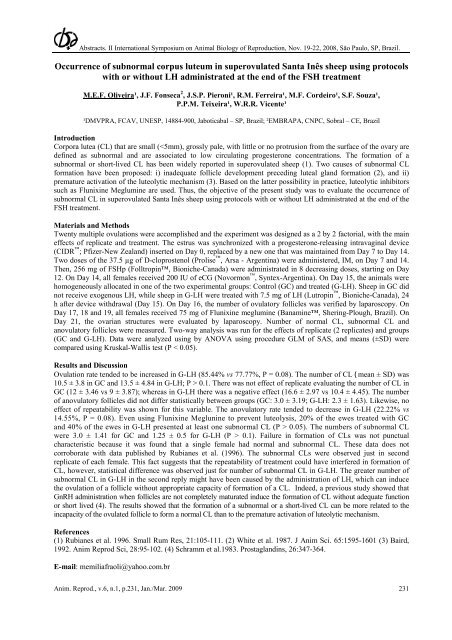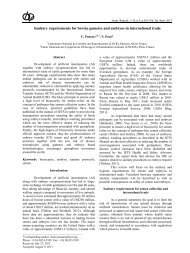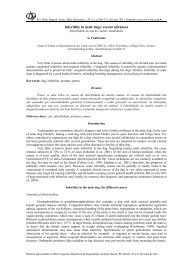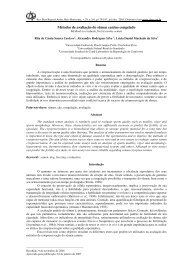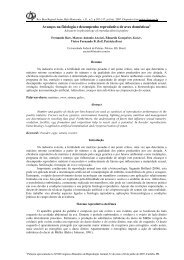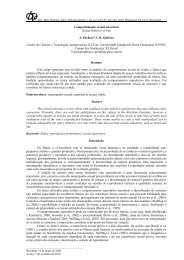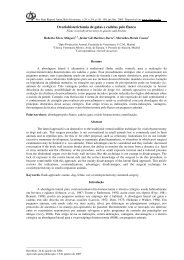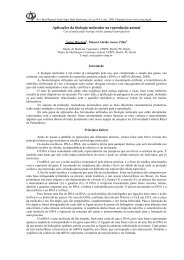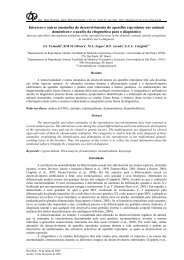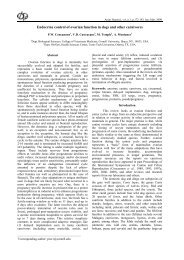Recent advances in ovulation synchronization and superovulation in ...
Recent advances in ovulation synchronization and superovulation in ...
Recent advances in ovulation synchronization and superovulation in ...
You also want an ePaper? Increase the reach of your titles
YUMPU automatically turns print PDFs into web optimized ePapers that Google loves.
Abstracts. II International Symposium on Animal Biology of Reproduction, Nov. 19-22, 2008, São Paulo, SP, Brazil.<br />
Occurrence of subnormal corpus luteum <strong>in</strong> superovulated Santa Inês sheep us<strong>in</strong>g protocols<br />
with or without LH adm<strong>in</strong>istrated at the end of the FSH treatment<br />
M.E.F. Oliveira¹, J.F. Fonseca 2 , J.S.P. Pieroni¹, R.M. Ferreira¹, M.F. Cordeiro¹, S.F. Souza¹,<br />
P.P.M. Teixeira¹, W.R.R. Vicente¹<br />
¹DMVPRA, FCAV, UNESP, 14884-900, Jaboticabal – SP, Brazil; ²EMBRAPA, CNPC, Sobral – CE, Brazil<br />
Introduction<br />
Corpora lutea (CL) that are small ( 0.1. There was not effect of replicate evaluat<strong>in</strong>g the number of CL <strong>in</strong><br />
GC (12 ± 3.46 vs 9 ± 3.87); whereas <strong>in</strong> G-LH there was a negative effect (16.6 ± 2.97 vs 10.4 ± 4.45). The number<br />
of anovulatory follicles did not differ statistically between groups (GC: 3.0 ± 3.19; G-LH: 2.3 ± 1.63). Likewise, no<br />
effect of repeatability was shown for this variable. The anovulatory rate tended to decrease <strong>in</strong> G-LH (22.22% vs<br />
14.55%, P = 0.08). Even us<strong>in</strong>g Flunix<strong>in</strong>e Meglun<strong>in</strong>e to prevent luteolysis, 20% of the ewes treated with GC<br />
<strong>and</strong> 40% of the ewes <strong>in</strong> G-LH presented at least one subnormal CL (P > 0.05). The numbers of subnormal CL<br />
were 3.0 ± 1.41 for GC <strong>and</strong> 1.25 ± 0.5 for G-LH (P > 0.1). Failure <strong>in</strong> formation of CLs was not punctual<br />
characteristic because it was found that a s<strong>in</strong>gle female had normal <strong>and</strong> subnormal CL. These data does not<br />
corroborate with data published by Rubianes et al. (1996). The subnormal CLs were observed just <strong>in</strong> second<br />
replicate of each female. This fact suggests that the repeatability of treatment could have <strong>in</strong>terfered <strong>in</strong> formation of<br />
CL, however, statistical difference was observed just for number of subnormal CL <strong>in</strong> G-LH. The greater number of<br />
subnormal CL <strong>in</strong> G-LH <strong>in</strong> the second reply might have been caused by the adm<strong>in</strong>istration of LH, which can <strong>in</strong>duce<br />
the <strong>ovulation</strong> of a follicle without appropriate capacity of formation of a CL. Indeed, a previous study showed that<br />
GnRH adm<strong>in</strong>istration when follicles are not completely maturated <strong>in</strong>duce the formation of CL without adequate function<br />
or short lived (4). The results showed that the formation of a subnormal or a short-lived CL can be more related to the<br />
<strong>in</strong>capacity of the ovulated follicle to form a normal CL than to the premature activation of luteolytic mechanism.<br />
References<br />
(1) Rubianes et al. 1996. Small Rum Res, 21:105-111. (2) White et al. 1987. J Anim Sci. 65:1595-1601 (3) Baird,<br />
1992. Anim Reprod Sci, 28:95-102. (4) Schramm et al.1983. Prostagl<strong>and</strong><strong>in</strong>s, 26:347-364.<br />
E-mail: memiliafraoli@yahoo.com.br<br />
Anim. Reprod., v.6, n.1, p.231, Jan./Mar. 2009 231


